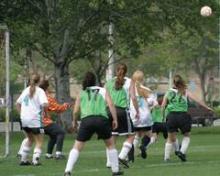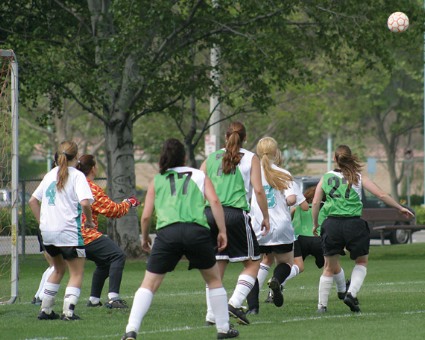User login
Concussions making headlines are no longer only relegated to NFL players and other professional athletes. Recent deaths from sports-related brain injuries among high school football players have shone the spotlight on another vulnerable set of athletes: teenagers and children.
But young football players are not the only ones susceptible to concussions. You can have a concussion in any sport. In fact, studies have shown that female soccer players are especially prone to this injury.
This occurrence was highlighted in a recent study of 351 elite female soccer players aged 11-14 years. Dr. John W. O’Kane of the University of Washington Sports Medicine Clinic in Seattle, and his colleagues found that this group has a higher rate of concussion than has been reported in studies of female soccer players at the high school and college levels. The cumulative concussion incidence in the study was 13% per season or 1.2 concussions per 1,000 athletic exposure hours (JAMA Pediatr. 2014 [doi:10.1001/jamapediatrics.2013.4518]).
Further, the study found that 58.6% of symptomatic players continued play and more than half of them (55.9%) were not evaluated by a qualified health care professional.
These findings underline the lack of awareness among athletes this age about the significance of concussions. It also stresses the importance of educating young athletes about the signs of a concussion and reinforcing that it is in their best interest to tell a coach or trainer when they’ve had a concussion. A lot of times, athletes will not tell anyone because they don’t want to be pulled out of the game, but continuing to play puts them at a greater risk.
Concussions need to be properly managed to prevent them from lasting longer than necessary. In the study, those with concussions had symptoms that lasted a median of 4 days. If athletes continue to play on, they are increasing their risk of sustaining another concussion because recurrence is more likely to happen within 10 days of the first concussion.
Additionally, athletes may be predisposing themselves to "second impact syndrome," which is extraordinarily rare, but when it happens, it’s typically catastrophic and may result in traumatic injury or death. Coaches, health care providers, parents, and especially the athletes need to pay attention to the severity and symptoms of the concussions, how long recovery takes, and the time between concussions.
Right now, based on what studies can tell, the biggest risk factor for chronic brain injuries associated with repetitive concussions is exposure. So the longer you play the sport, the higher the risk you have. For these middle school and high school athletes, that is not a significant problem, but there simply hasn’t been a lot of research done on youth athletes.
This recent study plus the Institute of Medicine’s review of sports-related concussion in athletes from elementary school through young adults that began in late 2013 are great first steps in increasing our understanding of the effects of concussion on young players and helping us to figure out the best way to combat this problem.
Dr. Jordan is the director of the brain injury program and the memory evaluation treatment service at Burke Rehabilitation Hospital in White Plains, N.Y. He currently serves as the chief medical officer of the New York State Athletic Commission, as a team physician for USA Boxing, and as a member of the NFL Players Association Mackey-White Traumatic Brain Injury Committee and the NFL Neuro-Cognitive Disability Committee.
Concussions making headlines are no longer only relegated to NFL players and other professional athletes. Recent deaths from sports-related brain injuries among high school football players have shone the spotlight on another vulnerable set of athletes: teenagers and children.
But young football players are not the only ones susceptible to concussions. You can have a concussion in any sport. In fact, studies have shown that female soccer players are especially prone to this injury.
This occurrence was highlighted in a recent study of 351 elite female soccer players aged 11-14 years. Dr. John W. O’Kane of the University of Washington Sports Medicine Clinic in Seattle, and his colleagues found that this group has a higher rate of concussion than has been reported in studies of female soccer players at the high school and college levels. The cumulative concussion incidence in the study was 13% per season or 1.2 concussions per 1,000 athletic exposure hours (JAMA Pediatr. 2014 [doi:10.1001/jamapediatrics.2013.4518]).
Further, the study found that 58.6% of symptomatic players continued play and more than half of them (55.9%) were not evaluated by a qualified health care professional.
These findings underline the lack of awareness among athletes this age about the significance of concussions. It also stresses the importance of educating young athletes about the signs of a concussion and reinforcing that it is in their best interest to tell a coach or trainer when they’ve had a concussion. A lot of times, athletes will not tell anyone because they don’t want to be pulled out of the game, but continuing to play puts them at a greater risk.
Concussions need to be properly managed to prevent them from lasting longer than necessary. In the study, those with concussions had symptoms that lasted a median of 4 days. If athletes continue to play on, they are increasing their risk of sustaining another concussion because recurrence is more likely to happen within 10 days of the first concussion.
Additionally, athletes may be predisposing themselves to "second impact syndrome," which is extraordinarily rare, but when it happens, it’s typically catastrophic and may result in traumatic injury or death. Coaches, health care providers, parents, and especially the athletes need to pay attention to the severity and symptoms of the concussions, how long recovery takes, and the time between concussions.
Right now, based on what studies can tell, the biggest risk factor for chronic brain injuries associated with repetitive concussions is exposure. So the longer you play the sport, the higher the risk you have. For these middle school and high school athletes, that is not a significant problem, but there simply hasn’t been a lot of research done on youth athletes.
This recent study plus the Institute of Medicine’s review of sports-related concussion in athletes from elementary school through young adults that began in late 2013 are great first steps in increasing our understanding of the effects of concussion on young players and helping us to figure out the best way to combat this problem.
Dr. Jordan is the director of the brain injury program and the memory evaluation treatment service at Burke Rehabilitation Hospital in White Plains, N.Y. He currently serves as the chief medical officer of the New York State Athletic Commission, as a team physician for USA Boxing, and as a member of the NFL Players Association Mackey-White Traumatic Brain Injury Committee and the NFL Neuro-Cognitive Disability Committee.
Concussions making headlines are no longer only relegated to NFL players and other professional athletes. Recent deaths from sports-related brain injuries among high school football players have shone the spotlight on another vulnerable set of athletes: teenagers and children.
But young football players are not the only ones susceptible to concussions. You can have a concussion in any sport. In fact, studies have shown that female soccer players are especially prone to this injury.
This occurrence was highlighted in a recent study of 351 elite female soccer players aged 11-14 years. Dr. John W. O’Kane of the University of Washington Sports Medicine Clinic in Seattle, and his colleagues found that this group has a higher rate of concussion than has been reported in studies of female soccer players at the high school and college levels. The cumulative concussion incidence in the study was 13% per season or 1.2 concussions per 1,000 athletic exposure hours (JAMA Pediatr. 2014 [doi:10.1001/jamapediatrics.2013.4518]).
Further, the study found that 58.6% of symptomatic players continued play and more than half of them (55.9%) were not evaluated by a qualified health care professional.
These findings underline the lack of awareness among athletes this age about the significance of concussions. It also stresses the importance of educating young athletes about the signs of a concussion and reinforcing that it is in their best interest to tell a coach or trainer when they’ve had a concussion. A lot of times, athletes will not tell anyone because they don’t want to be pulled out of the game, but continuing to play puts them at a greater risk.
Concussions need to be properly managed to prevent them from lasting longer than necessary. In the study, those with concussions had symptoms that lasted a median of 4 days. If athletes continue to play on, they are increasing their risk of sustaining another concussion because recurrence is more likely to happen within 10 days of the first concussion.
Additionally, athletes may be predisposing themselves to "second impact syndrome," which is extraordinarily rare, but when it happens, it’s typically catastrophic and may result in traumatic injury or death. Coaches, health care providers, parents, and especially the athletes need to pay attention to the severity and symptoms of the concussions, how long recovery takes, and the time between concussions.
Right now, based on what studies can tell, the biggest risk factor for chronic brain injuries associated with repetitive concussions is exposure. So the longer you play the sport, the higher the risk you have. For these middle school and high school athletes, that is not a significant problem, but there simply hasn’t been a lot of research done on youth athletes.
This recent study plus the Institute of Medicine’s review of sports-related concussion in athletes from elementary school through young adults that began in late 2013 are great first steps in increasing our understanding of the effects of concussion on young players and helping us to figure out the best way to combat this problem.
Dr. Jordan is the director of the brain injury program and the memory evaluation treatment service at Burke Rehabilitation Hospital in White Plains, N.Y. He currently serves as the chief medical officer of the New York State Athletic Commission, as a team physician for USA Boxing, and as a member of the NFL Players Association Mackey-White Traumatic Brain Injury Committee and the NFL Neuro-Cognitive Disability Committee.

